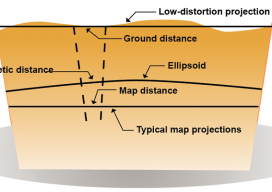All posts by Charles D. Ghilani
Where Theory Meets Practice: Transformations and Reference Frames, Part 1
A year ago I watched as a surveyor pulled out his GNSS receiver with a real-time network data link to perform a site survey for a local construction project. I took this opportunity to ask him if he could locate a Continuously Operating Reference Station (CORS) reference monument. Because he also needed this monument, he...

Transformation of Observations, Part 3
Above: Typical and low-distortion map projections. Using a Project Factor In Part 1 of this series of articles (September 2014 issue), I explained how to transform surface observations into a geocentric coordinate system so that it could be compared to GNSS baseline vectors. In Part 2 (December 2014) I explained how the creation of a...
Where Theory Meets Practice: Geodetic Observations: Part 1
Since the inception of GPS in the 1980s, surveyors have been presented with GPS baseline reduction results that list both geodetic azimuths and distances for the baseline vectors. In Part I of this article, I present the difference between the normal to the geoid and ellipsoid, which is known as deflection of the vertical, and...
Guest Essay: Change is Hard, But It’s Not the End
Chances are that students currently enrolled in surveying and geomatics programs are familiar with the writings of Dr. Charles Ghilani, author of such reference/textbooks as Adjustment Computations: Spatial Data Analysis and Elementary Surveying (An Introduction in Geomatics). Dr. Ghilani is a professor of engineering in the Surveying Engineering Program at Pennsylvania State University. He received his PhD...
Where Theory Meets Practice: Geodetic Observations – Part 2
Part 1 of this article (March 2014) presents the differences between azimuths that surveyors observe with a total station and the geodetic azimuths listed in GNSS adjustment reports. However, the effect on angles caused by the deflection of the vertical at the observing station is typically small. Thus, the difference between the observed astronomic angle and...
Where Theory Meets Practice: Transformations and Reference Frames, Part 2
In the previous article (PSM Dec. 2013), I mention the practical problems of control being in different reference frames, and I present the surveying solution to this problem. In this article I address how to determine if the localization process was successful. To do this we will need to look at the statistics of the...
